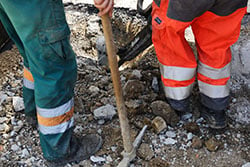Since 1970, the Occupational Safety and Health Act has saved the lives of more than 553,000 workers. But there are still thousands of dangerous jobs. And construction is one of the most hazardous fields of all.
According to OSHA, the fatal injury rate in construction is higher than the national average for all industries.
The owners of most firms make the health and safety of employees their highest priority. But sadly, there are cases where construction executives fail to do their utmost to keep all of their workers safe.
Trench Collapse
Trenching is near the top of OSHA’s list of hazards. There’s no denying that it’s one of the most dangerous jobs in construction – just one cubic yard of dirt can weight up to 3,000 pounds.

OSHA has safety standards in place that specifically address trenching. It also requires that contractors properly train workers on trench safety. Yet fatal trenching accidents still more than doubled in 2016.
In that year, a judge found general contractor Harco Construction guilty of manslaughter in the death of 22-year-old construction worker Carlos Moncayo. On August 6, 2015, Moncayo was buried alive when an unshored 14-foot trench caved in at a building site in Manhattan.
Prosecutors said Harco and the sub-contractor that employed Moncayo were reckless, as they had ignored warnings from inspectors.
On August 5, just one day before the trench collapse that took Moncayo’s life, the Manhattan District Attorney’s office issued a press release announcing the creation of a task force to investigate “wrongdoing and unsafe practices” at construction sites in the city.
Falls From Heights
Guardrails, safety nets, and restraint systems are among the best ways to protect workers from falls. But in 2015, falls were responsible for 364 construction deaths. This is almost 40% of all deaths in the industry during that year.
On July 24, 2014, iron worker Eric Roach fell approximately 30 feet while working on a job site in Kansas City. He died the following day at a local hospital.
Roach had been helping another worker receive 26-foot bundles of decking on top of a partially-completed building. Roach and other workers on the site were walking on narrow trusses high off the ground. But none were wearing fall protection.
The contract signed by Roach’s employer required the company to provide fall protection to anyone working more than six feet off the ground. The court found that the foreman knew workers weren’t using fall protection that day, yet failed to correct the situation.
In 2017 A federal judge found the company guilty of violating OSHA rules.
Structure Collapse
Between 2010 and 2015, OSHA’s Directorate of Construction investigated 23 structure collapses. 24 construction workers were killed in these incidents.
Many factors can cause a scaffold, crane, or building to collapse. Examples include flawed architectural plans, improper construction techniques, and sub-standard materials. Sometimes, multiple things go wrong. When that happens, the results can be catastrophic.
On October 30, 2003, a partially-completed parking garage at the Tropicana Casino and Resort in Atlantic City, New Jersey collapsed. Four workers died.
OSHA found that poor construction techniques caused the disaster. Five of the garage’s ten stories collapsed due to a failure to provide adequate temporary supports while the concrete dried. Also, the steel reinforcements in the concrete were not properly anchored to the supporting columns.
Multiple firms contributed to the collapse: Fabi Construction, Keating Building Construction, Mitchell Bar Placement, and Site-Blauvelt Engineers. The companies were charged with a total of $119,500 in violations.
OSHA has made great strides toward preventing injuries and saving the lives of workers across all industries. But the toll taken on construction workers and their families due to injuries and deaths is still too high.
Even more vigilance is required for the number of construction worker injuries and deaths to hit the only acceptable target number: zero.
Sources: AFLCIO.org, Newsday.com, Failures.wikispaces.com, OSHA.gov, BusinessInsurance.com, ConstructionDive.com

“Helping our clients get jobs done since 1998.”